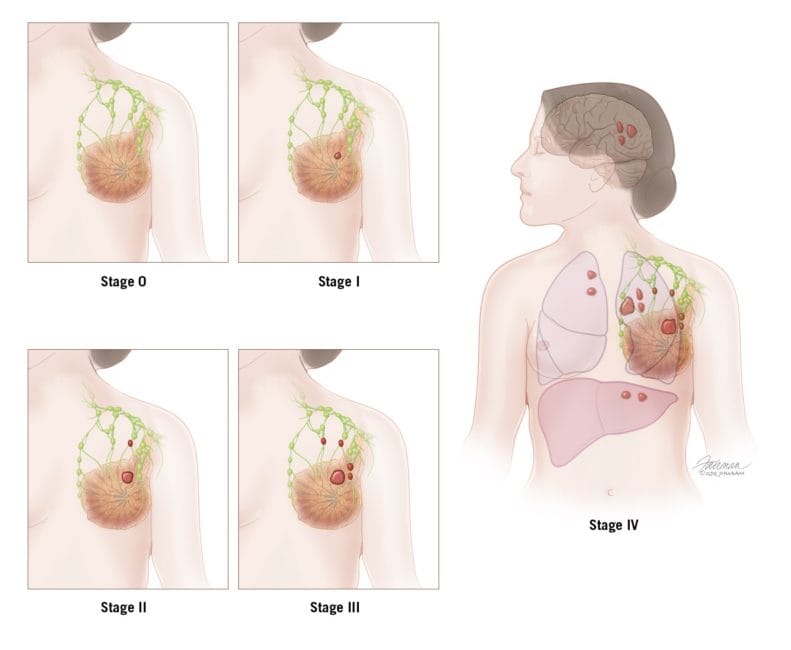
The size of your tumour can influence the identification of the stage of breast cancer you are currently in. Find out more about the implications of breast tumour size on cancer.
Breast cancer is one of the most prevalent cancers among Indian women. As per a 2019 report published in NCBI, breast cancer constitutes more than 30 per cent of all cancers in females.
The survival rate largely depends on early diagnoses and the right treatment.
Breast tumour size is an important factor in determining breast cancer stage but not the only one. Other factors like the location of the tumour, how much it has spread, hormone receptor status also play a significant role in deciding the stage of breast cancer.
Doctors use various tests and examinations to evaluate the specific characteristics of a person’s breast cancer while determining breast cancer stages.
The diagnostics tests and scans of the person help the doctors in tumour staging. The TNM staging system is a commonly used tool to describe the stage.
Combined results are used to determine the stage of cancer for each person.
Tumour size is generally measured in millimetres (mm) or centimetres (cm). A number suffixed with T tells you the main tumour’s size. Higher the number, larger is the tumour and its spread.
The American Cancer Society uses this particular system for tumour staging:
TX – The primary tumour cannot be evaluated
T0 – No evidence of cancer in the breast
T1 – The tumour detected is less than 20 mm in size. It further has four sub-stages categorized as per the size of tumour:
T2 – When the tumour is larger than 20 mm but smaller than 50 mm
T3 – When the tumour is larger than 50 mm
T4 – The tumour has grown into the chest wall and/or skin. It also includes inflammatory breast cancer.
The N value of the TNM staging system assesses whether cancer has spread to the nearby lymph nodes. The doctor generally takes the sample from the armpit area called the axillary lymph nodes and graded through the following:
When cancer cells have spread to distant organs or tissues of the body, it is metastatic breast cancer. The most common metastatic areas are the liver, bones, and lungs. The assessment is as follows:
MX – Unable to evaluate the distant spread
M0 – No evidence found for cancer spreading to distant parts
M1 – Cancer has spread to distant parts
Breast tumour size is one crucial determinant of the cancer stage along with lymph node and metastatic status.
However, some other deciding factors that doctors use to evaluate breast cancer staging are:
Knowing the hormone receptor status is essential in tumour staging and also deciding an effective breast cancer treatment plan. For this, the doctors evaluate the breast cancer cells for specific proteins that are estrogen and progesterone receptors.
The cancer cells often attach themselves to these hormones and feed on them to grow.
Hormone therapy is generally the most effective treatment in such cases. It prevents estrogen and progesterone from attaching themselves to the receptors, thereby keeping cancer from growing and spreading.
One of the newest determinants to be incorporated into breast cancer staging is HER2 status. HER2, i.e., human epidermal growth factor receptor 2, is a gene that can play a role in the development of breast cancer.
HER2 receptors are proteins that control how a healthy breast cell grows, divides, and repairs itself. Doctors test HER2 status to see if there are higher than normal levels of this receptor and then term it as HER2 positive cancer.
Targeted therapies generally work best in such cases.
This is known as breast cancer grading. In this, the breast cancer cells are carefully observed under a microscope for their appearance.
The ones that look quite similar to normal cells are considered to be slower growing. Contrarily, the ones that look very different will probably grow and spread faster.

Depending on the stage of breast cancer, age and general health of the patient, your doctor will prepare a treatment plan.
Options include:
Every person’s breast cancer is different. The tumour staging helps in evaluating the extent of cancer present and deciding the best suitable treatment option for it.
Breast tumour size is undoubtedly the most important deciding factor for breast cancer staging. Early diagnosis holds the key to the efficient and effective treatment of breast cancer. It is important to consult your doctor right away whenever you feel you show any signs or symptoms of breast cancer.
Written and Verified by:

Similar The Breast Centre Blogs
Request a call back